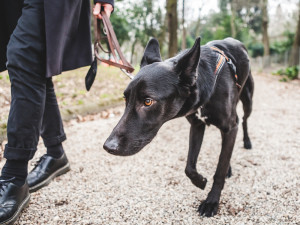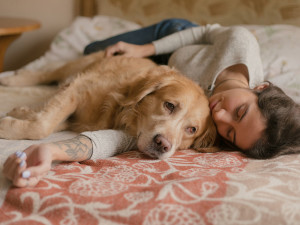Why Is My Dog Being Clingy?
Your dog’s Velcro habits are cute—but not always convenient.

Share Article
Dog parents love snuggling with their pups, whether in bed or cozying up on the couch. But some dogs are a little too eager for cuddles and never want to leave their human parents’ sides. They may even panic when you step outside to check the mail or leave their sight for only a few minutes. “Why is my dog so needy for attention?” you wonder.
Why are some dogs extra clingy, and should this behavior be a cause of concern for pet parents? Kinship spoke to professional dog trainer Brittany Fultonopens in new tab about why your dog may be attached to your hip and what you can do to teach them to be a little more confident on their own.
What is clingy behavior in dogs?
Dogs are social animals, and they have evolved tight bonds with their human companions, so it’s totally normal for your dog to want your attention and affection. But a dog being clingy could be a sign of a deeper issue, such as anxiety, stress, or even an underlying health problem.
Clingy behavior in so-called “Velcro dogs” (because they stick to their human parents) can manifest in a variety of ways. Your dog likely will be reluctant to leave your side and may even follow you from room to room. They may act uncertain or even anxious when you prepare to leave the house and could lean against you or need to touch you in some way whenever you’re near.
What are the early signs of clingy behavior in dogs?
Knowing the signs of a clingy dog can help you recognize this behavior and start addressing the issue ASAP. When you recognize your dog’s clingy behavior, you can get a clearer understanding of their needs and figure out how to make your dog less clingy. Look out for these signs:
Constantly following you
Restlessness or reluctance to settle down
Excessing barking or whining
A frequent need for attention
Refusal to eat or drink alone
Trouble sleeping alone
Very emotional at reunions with you
Lack of interest in toys or playtime
Often seeking physical contact with you
Hesitant to explore on their own
When you recognize signs of this behavior early on, you can consider investing in training and working on socialization to help your dog feel more comfortable and confident.
“A variety of training focuses can reduce the anxiety and fear that commonly produce hyper-attachment,” Fulton says. “Properly socializing a young dog familiarizes them with many events that life will throw at them.”
What should I do if my dog is being clingy?
Like any behavioral issue, addressing clinginess requires understanding, patience, and consistent positive reinforcement. Remember that the goal is to help your dog become more independent and confident, able to enjoy the world without you constantly at their side.
“If a pet parent observes clingy behavior, I recommend reassuring and properly distracting their dog,” Fulton says. “It’s important to remember that we cannot reinforce, and therefore increase, a behavior that is motivated by an emotion. Putting your dog’s attention on something other than the anxiety-inducing event or stimulus can help them.”
Follow these tips to take care of a clingy dog so you can help your pet feel more comfortable standing on their own four feet.
Identify the underlying cause.
The best way to help your dog with their clinginess is to understand why they feel a need to stay close to you. Some dogs may just lack confidence and seek reassurance and protection by being near you, while others may develop clingy behavior as a result of past trauma or neglect.
“Anxiety is often the leading cause for clingy behavior,” Fulton says. “I see and hear about this most frequently when a dog is in a new and unfamiliar situation or environment. Uncertainty contributes heavily to anxiety. The dog may be uncertain about how to behave, what is safe or dangerous, or what will happen next.”
If your dog acts panicked without you, their behavior may actually be caused by separation anxiety. Dogs who experience separation anxiety become distressed when separated from their human parents and may exhibit destructive behaviors.
Rule out any health problems.
If your dog is very clingy all of a sudden, a health issue may be the underlying cause. If your dog feels pain or discomfort, they may seek you out more often for extra attention. Pay attention to your dog’s behavior and if you notice any other sudden changes in behavior or symptoms of illness, consult your veterinarian to see if their clinginess is a result of a health problem.
Provide your dog with plenty of exercise and mental stimulation.
Often, a clingy dog just needs a little extra physical and mental stimulation. Exercise can help tire your dog out and reduce stress, so go for that daily walk or play a game of fetch. Consider investing in puzzles and other interactive toys to help your dog stimulate their mind and channel their energy in a healthy way.
Establish a routine.
Dogs thrive on consistency, so make sure you have a daily schedule for meals, playtime, and bedtime — and stick to it. This structure and predictability can make your dog feel more at ease, helping to reduce clingy behavior.
Gradually introduce your dog to being alone.
If your dog becomes anxious when you leave the house, slowly desensitize them to alone time. Start with only leaving for a short time and gradually increase the duration. Make sure to reward your dog when they act calm. You can also consult with a professional dog trainer or behaviorist, who can provide you with a personalized plan to help accustom your dog to being alone.
Reward your dog for calm and independent behavior.
Positive reinforcement training helps your dog understand what behaviors you want to see from them. Consider enrolling in a dog training class or work on basic commands on your own. Always reward good behavior with praise and treats. Slowly expose your dog to new environments and experiences through controlled socialization and reward them for maintaining calm.
“If your dog hasn’t been gifted with a history of excellent socialization, you can gradually expose them to new situations at their own pace,” Fulton emphasizes. “It’s important not to throw the learning swimmer (your dog) into the deep end of the pool. You can encourage your dog to enter new situations, but you must give them the option to disengage. Otherwise, you may associate even stronger negative emotions with the situation.”
Seek professional help if needed.
If none of these tips work for you and you’re still wondering why your dog is a stage-five clinger, it’s time to reach out to a professional. A certified dog trainer or veterinary behaviorist can determine your dog’s needs and help guide you to address their clingy behavior.
FAQs (People also ask):
Is it OK to ignore my clingy dog?
Ignoring any unwanted behavior is not the most effective approach. Instead, reward your dog when they display independence or self-soothing behaviors.
Is it normal for my dog to suddenly become clingy?
If you find yourself googling, “Why is my dog acting weird and clingy?” there may be an obvious reason. Changes to your dog’s routine or environment, like a new home or new family member, can lead to stress and anxiety, which can manifest in clingy behavior. Make sure to offer your dog stability and reassurance during any times of change. If the behavior interferes with your dog’s well-being, consult your vet.
Can professional training help with a clingy dog?
Professional training can help build your dog’s confidence, as well as provide mental stimulation. A certified trainer can build a program around your dog’s needs to help reduce clingy behaviors.
Is clingy behavior a sign of separation anxiety in dogs?
Clingy behavior can be a symptom of separation anxiety in dogs, but usually there are other signs as well, such as extreme distress when left alone, excessive barking or whining, and destructive behavior. Talk to your vet to determine if separation anxiety is the underlying cause of your dog’s clinginess.
How can I help my dog with separation anxiety?
Separation anxiety in dogs requires the guidance of a professional to help reduce anxiety and modify the behavior. Consult a veterinary behaviorist to work with you and your dog and help manage your pet’s separation anxiety. And remember that improving the behavior will take time, so be patient.
“Let go of your own mile markers and find accomplishments in the process that you can praise and reward,” Fulton says. “Both of you will have a better experience if you do this!”

Savannah Admire
Savannah Admire is a writer, poet, and pet mom to three dogs and a cat. She currently lives in Western Maryland. When she’s not writing, you can find her reading, taking photos, or volunteering as a content creator for her local community theatre. Her debut poetry book, Mother Viper, is forthcoming on August 12, 2025.
Related articles
![A dog sitting in a chair staring out a window.]()
Celeb Dog Trainer Nicole Ellis on Getting Your Dog Used to Your Office Return
It’s 2023, and the office is calling. How can our dogs cope?
![Muscular white pit bull stands on couch, looking out window to sunny fall day.]()
Separation Anxiety in Dogs
Does your dog freak out when you head for the door? Here’s some advice.
![a child with a backpack walking a dog, a collage of products over the image: a sweater, a backpack, a milk toy, a puzzle toy, calming supplements]()
15 Products to Help Your Dog Adjust to Back to School
Because this season should mean more fun—and less stress—for your pup.
![Woman and white dog playing with puzzle.]()
6 Genius Interactive Dog Toys From Nina Ottosson
These puzzle toys are made to help you bond with your pup.
![Shy black dog walking with owner at the park.]()
How to Help an Anxious Dog Conquer Their Fears
Pro tips for boosting the confidence of a scaredy-cat dog.
Does Your Dog Need Anti-Anxiety Meds?
How to cope with dog anxiety—from training to medication.











